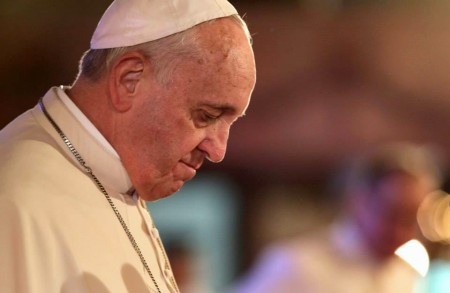We ask you, humbly: don't scroll away.
Hi readers, it seems you use Catholic Online a lot; that's great! It's a little awkward to ask, but we need your help. If you have already donated, we sincerely thank you. We're not salespeople, but we depend on donations averaging $14.76 and fewer than 1% of readers give. If you donate just $5.00, the price of your coffee, Catholic Online School could keep thriving. Thank you.Help Now >
Bernardino de Sahagún
FREE Catholic Classes
Missionary and Aztec archeologist, b. at Sahagún, Kingdom of Leon, Spain, in or before the year 1500; d. at Mexico, 23 Oct., 1590. He studied at the convent of Salamanca where he took the vows of the order, and in 1529 was sent out to Mexico, being one of the earliest missionaries assigned to that country, where he labored until his death more than sixty years later. He was assigned to the college of Santa Cruz in Tlaltelolco, near the City of Mexico, and took up the work of preaching, conversion, and the instruction of the native youth in Spanish and Latin, science, music, and religion, while by close study and years of daily practice he himself acquired such mastery of the Aztec language as has never since been attained by any other student. Although several times filling administrative positions, he preferred to devote his attention solely to the work of instruction and investigation. His zeal and pre-eminent ability in respect to the Indian language and religion attracted the attention of his superior, who directed him to compile in the Aztec language a compendium of all things relating to the native history and custom that might be useful in the labor of Christianizing the Indians. The work thus undertaken occupied some seven years, in collaboration with the best native authorities, and was expanded into a history and description of the Aztec people and civilization in twelve manuscript books, together with a grammar ( Arte ) and dictionary of the language.
 Hi readers, it seems you use Catholic Online a lot; that's great! It's a little awkward to ask, but we need your help. If you have already donated, we sincerely thank you. We're not salespeople, but we depend on donations averaging $14.76 and fewer than 1% of readers give. If you donate just $5.00, the price of your coffee, Catholic Online School could keep thriving. Thank you. Help Now >
Hi readers, it seems you use Catholic Online a lot; that's great! It's a little awkward to ask, but we need your help. If you have already donated, we sincerely thank you. We're not salespeople, but we depend on donations averaging $14.76 and fewer than 1% of readers give. If you donate just $5.00, the price of your coffee, Catholic Online School could keep thriving. Thank you. Help Now >
Various delays enabled the author to continue revisions and additions for several years. One of these delays hinged upon the question of the hiring of clerical assistance as inconsistent with the Franciscan vow of poverty, although Father Sahagún, by reason of age and the trembling of his hand, was then unable to write himself. After five years of waiting it was decided in favor of the author, who was given the help he needed, and the complete Aztec manuscript with the grammar and dictionary, was finished in 1569. In the meantime a preliminary manuscript draft had been carried to Spain, where it became known to Ovando, president of the Council of the Indies, on whose request the Franciscan delegate general directed Father Sahagún to make a complete Spanish translation, furnishing all necessary assistance. On account of the fear of encouraging the educated natives to dwell upon their heathen past—a very real danger at the time &151; and on account also of the author's strictures upon the methods of the Conquistadores , it was not published, but was consulted in manuscript, being sent from one to the another college of the order, until finally carried to Spain and deposited in the convent of Tolosa, where it was found, and a copy made, by the archivist Muñoz shortly before 1800. It was published under the title "Hlstoria general de las cosas de Nueva España" in three volumes at Mexico in 1829, and in volumes five and seven of Kingsborough's "Mexican Antiquities", London, 1831.
Father Sahagún thus describes the inception of the work: "I was commanded in all holy obedience by my chief prelate to write in the Mexican language that which appeared to me to be useful for the doctrine, worship, and maintenance of Christianity among these natives of New Spain, and for the aid of the ministers and workers that taught them. Having received this commandment, I made in the Spanish language a minute or memorandum of all the matters that I had to treat of, which matters are what is written in the twelve books . . . which were begun in the pueblo of Tepeopulco. . . . I got together all the principal men, together with the lord of the place, who was called Don Diego de Mendoza, of great distinction and ability well-experienced in things ecclesiastic, military, political, and even relating to idolatry. They being come together, I set before them what I proposed to do, and prayed them to appoint me able and experienced persons with whom I might converse and come to an understanding on such questions as I might propose. They answered me that they would talk the matter over and give their answer on another day; and with this they took their departure. So on another day the lord and his principal men came and having conferred together, with great solemnity, as they were accustomed at that time to do, they chose out ten or twelve of the principal old men, and told me that with these I might communicate and that these would instruct me in any matters I should inquire of. Of these there were as many as four instructed in Latin, to whom I, some few years before, had myself taught grammar in the college of Santa Cruz in Tlaltelolco. With these appointed principal men, including the four instructed in grammar, I talked many days during about two years, following the order of the minute I had already made out. On all the subjects on which we conferred they gave me pictures—which were the writings anciently in use among them—and these the grammarians interpreted to me in their language, writing the interpretation at the foot of the picture."
Besides the "Historia", the "Arte" and the "Diccionario" (the last in Aztec, Spanish, and Latin) he was the author of a number of lesser works, mostly religious and in the Aztec language, among which may be noted a volume of sermons ; an explanation of the Epistles and Gospels of the Mass; a history of the coming of the first Franciscans to Mexico, in two volumes; a Christian psalmody in Aztec, for the use of the neophytes in church (Mexico, 1583-84), and a catechism in the same language. He died at the age of ninety years, sixty-one of which had been devoted to missionary labor and research. At his funeral, which was attended by all the religious and students of the city, the Indians also attended, shedding tears. In Sahagún we have the ideal missionary priest and scholar. As a young man he was noted for his beauty and grace of person, and from childhood was given to prayer and self-restraint. His religious companions affirmed that he went into frequent ecstasies. He was most exact in the duties of his order, never missing Matins, even in his old age. Always and to all persons he was gentle, humble, and courteous. In over sixty years as college professor he rested not for a day "teaching civilization and good customs, reading, writing, grammar, music, and other in the service of God and the state". In addition to his unequaled mastery of the Mexican language, it was said of him that he excelled in all the sciences.
We ask you, humbly: don't scroll away.
Hi readers, it seems you use Catholic Online a lot; that's great! It's a little awkward to ask, but we need your help. If you have already donated, we sincerely thank you. We're not salespeople, but we depend on donations averaging $14.76 and fewer than 1% of readers give. If you donate just $5.00, the price of your coffee, Catholic Online School could keep thriving. Thank you.Help Now >








 Daily Readings for Friday, April 19, 2024
Daily Readings for Friday, April 19, 2024 St. Alphege: Saint of the Day for Friday, April 19, 2024
St. Alphege: Saint of the Day for Friday, April 19, 2024 Stewardship Prayer: Prayer of the Day for Friday, April 19, 2024
Stewardship Prayer: Prayer of the Day for Friday, April 19, 2024
